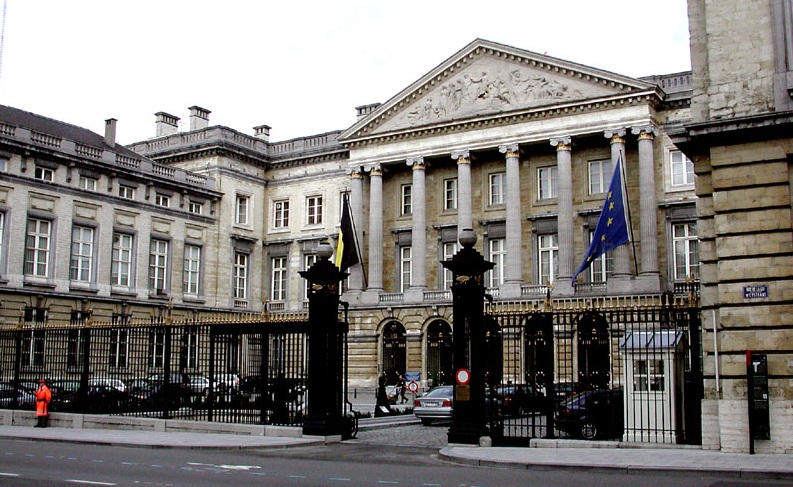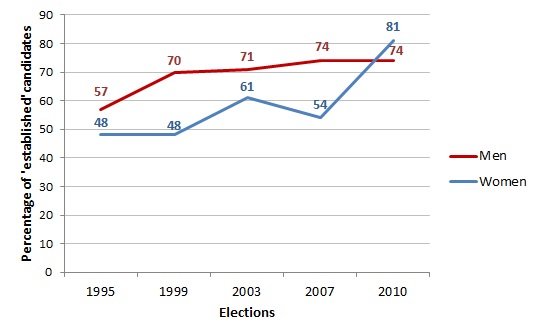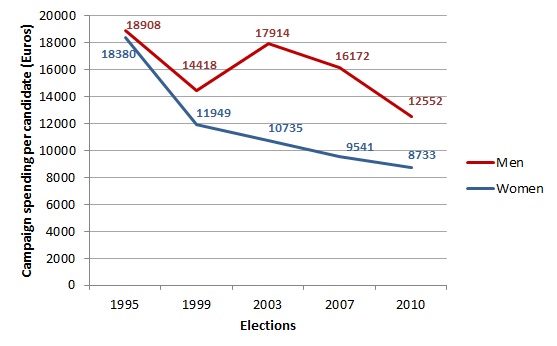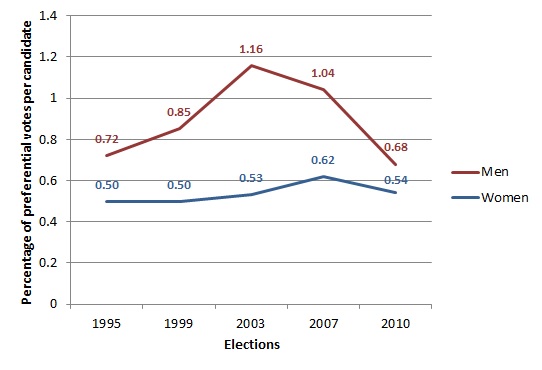How have Belgian parties changed their behaviour after the introduction of a gender quota for election candidates?
Many democracies have relatively low levels of female representation in public life, including the UK, where less than a quarter of MPs in the House of Commons are women. Other countries have introduced quotas to address this problem, including Belgium. In this post, Bram Wauters, Bart Maddens and Gert-Jan Put explore how Belgian political parties responded after this reform was introduced.

The Palace of the Nation in Brussels. How do political parties act to get women elected? Credit: Klever (CC BY-SA 3.0)
According to Quota Project, an international database on the parliamentary representation of women, half of the countries worldwide are using some form of gender quotas to remedy the under-representation of women in parliaments. The effects of these quota initiatives have been widely debated and examined in both the academic and public arena. A very straightforward way to evaluate these effects is to analyse the number of elected women. We switch here the focus to the willingness of parties to equally support male and women candidates in campaigns and elections.
This blog post discusses how quota regulations affect party elite behaviour in supporting women candidates. Do political parties support women more equally after the introduction of quota? We examine evidence from the Belgian Senate elections, where quota regulations are into play since 1999.
The nature of Belgian quota regulations
The Belgian political elite was quite early in adopting quota regulations. In fact, the initial Belgian quota law has even been a model for other countries, although the system introduced in Ireland operates in a different way.
The first Belgian quota law was introduced in 1994 and first applied for the Senate elections in 1999. It stated that no more than two thirds of the candidates on party lists could be of the same sex. In 2002, this law was adapted in the sense that candidate lists should from then on include an equal number of male and female candidates. In addition, at least one of the top two positions on the party list (only in 2003 still one of the top three) should be reserved for women.
As a result, the current Belgian quota regulations are well-adapted to the ‘flexible list’ electoral system, where both the rank order of candidates and the number of preferential votes come into play when determining who gets elected. This significantly increased the number of female MPs. But has it changed the behaviour of party elites in their support of female politicians as well?
Expectations: initial stubbornness, followed by adaptation
Initially, party elites will be hesitant to equally support women candidates. First, male and female politicians differ in their acceptance of quota regulations. While men think that the under-representation of women is due to factors on the individual level (lack of political interest, etc.), women are convinced that their disadvantaged position can be explained by structural factors, which can only be overcome by structural measures, such as quotas.
Second, given the traditional male dominance in the political sphere, men are thought to be more likely to succeed in politics. On top of that, critics fear that the requirement to nominate more women candidates will lead to the election of women that are not up to the job. Therefore, party elites are not likely to give women much support.
Third, party elites responsible for the selection of candidates, distribution of campaign budgets, etc., are predominantly male. They see women as an out-group and assess individual women candidates by using stereotypes, leading them to judge women candidates as less politically capable.
After running a couple of elections using quotas, however, there might be some improvement in the situation of women candidates, we expect. Party elites become used to prominent women politicians, which has a positive effect on the party support they enjoy. In addition, also a strategic considerations might prevail. Finally, women might also become part of the party elite that decides on candidate selection and campaign support.
We measured party elite behaviour by looking at gender differences in indicators that are strongly influenced by party elites: list position, candidate seniority, campaign expenses and preferential votes.
Average list position
Concerning list positions, the introduction of quota regulations have indeed initially worsened the average list position of women candidates. Until recent reforms Belgians directly elected 40 members of the Senate – under the list system, parties put forward a list of candidates for each constituency. A higher position on their party list for a candidate makes it more likely that candidate will be elected.
After the gender quota system was introduced, however, female prominence on party lists fell slightly. In 1995, the average list position of female candidates was 12.2 (for men it was 13.4). By 2007, however, women’s average list position had fallen to 13.8 (men were at 12.3). At the last election women’s average position increased to 12.95, putting them slightly ahead of men again.
Candidate seniority
With regard to candidate seniority, we see an influx of new women candidates in the first elections after the adoption of quota regulations (1999 and 2003). Afterwards, the number of politically experienced women standing for the Senate increases due to a gain in confidence in women’s political role and the creation of a female political elite. The increase was slow until the most recent election: in 2010 we found a marked increase in the number of experienced female candidates, which was then even higher than the percentage amongst men.
Figure 1: Candidate seniority among Belgian Senate election candidates, 1995-2010
‘Established’ = Candidates who have previously been a candidate for either House of Representatives, Senate, European or Flemish Parliament since 1987.
Campaign expenditure
The third indicator, campaign expenses, needs some additional explanation. The amount which a candidate is allowed to invest in the campaign is to a large extent determined by the party. In Belgium, political parties may select a limited number of candidates who are allowed to spend a much larger amount than regular candidates. Figure 2 below shows the evolution in the average campaign expenses of male and women candidates, and the difference between the two groups. While spending levels were more or less comparable before the introduction of quota regulations (1995), the average expenses of women candidates have declined from 1999 until 2010. This produced a widening gap between male and female campaign expenditures, amongst others because of the fact that there were relatively fewer women than men allowed to spend the maximum. The convergence in 2010 might indeed indicate gradual changes in the party elite behaviour.
Figure 2: Campaign expenditure for Belgian Senate election candidates, 1995-2010
Preferential votes
The fourth and final indicator is the difference in preferential votes for male and women candidates. In the flexible list system – unlike the closed list system used for European Parliament elections in the UK – voters can choose their preferred candidates within the party list. Although relatively few voters choose to do this, instead voting for the whole list in the order put forward by the party.
Women have obtained fewer preferential votes at the past five elections, and the gap with male candidates strongly widened in 1999 and 2003. But in 2007 and 2010, there was a convergence due to a sharp fall in preferential votes for men. The pattern is shown in Figure 3 below.
Figure 3: Preferential votes per candidate in Belgian Senate elections, 1995-2010 (percentage of total votes)
This pattern again conforms to our expectations. The initial sharp increase in preferential votes for men is probably due to the fact that, after the less popular male candidates were replaced by women candidates, the remaining men tended to be more popular than the neophyte women. But by 2007, these new candidates seem to be considered by the party as politically ‘mature’ and received a larger share of preferential votes.
What can we learn from the Belgian case? Our results indicate that it takes a rather long time for party elites to adapt their attitudes. Only in the third election after the introduction of gender quotas (2007), a rise in the indicators was noted. This demonstrates that party elites are initially very reluctant to equally support women candidates. However, the positive trend observed in the 2010 elections gives us reasons to end with an optimistic note and to expect further improvement in the near future.
—
Information for this post is drawn from: Wauters, B., Maddens, B. and Put, G.J. (2014) It takes time: the long-term effects of gender quota, Representation, published online.
Note: This post represents the views of the authors, and does not give the position of LSE or Democratic Audit. Please read our comments policy before responding. Shortlink for this post: buff.ly/1gsoA1s
—
 |
Bram Wauters is a Professor at the Department of Political Sciences of the Ghent University. |
 |
Bart Maddens is a Senior Lecturer in the Faculty of Social Science, University of Leuven. |
 |
Gert-Jan Put is a Research Fellow in the Faculty of Social Science, University of Leuven. |








 Democratic Audit's core funding is provided by the Joseph Rowntree Charitable Trust. Additional funding is provided by the London School of Economics.
Democratic Audit's core funding is provided by the Joseph Rowntree Charitable Trust. Additional funding is provided by the London School of Economics.
RT @LSEPubAffairs: How have Belgian parties changed their behaviour after the introduction of a gender quota for election candidates? http:…
How have Belgian parties changed their behaviour after the introduction of a gender quota for election candidates? https://t.co/KruYN4K1zp
How have Belgian parties changed their behaviour after the introduction of a gender quota for election candidates? https://t.co/5xeJ1bXrWY